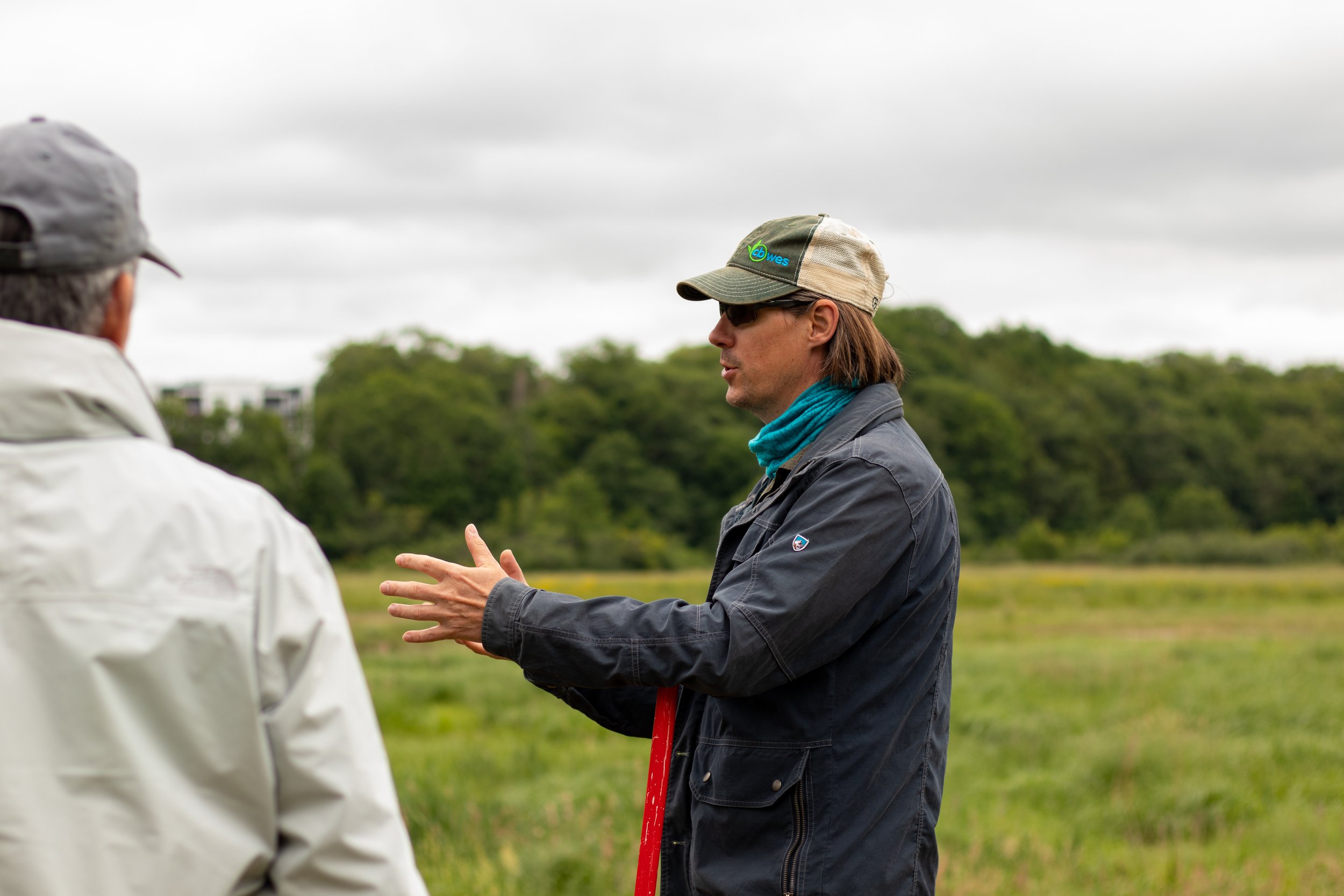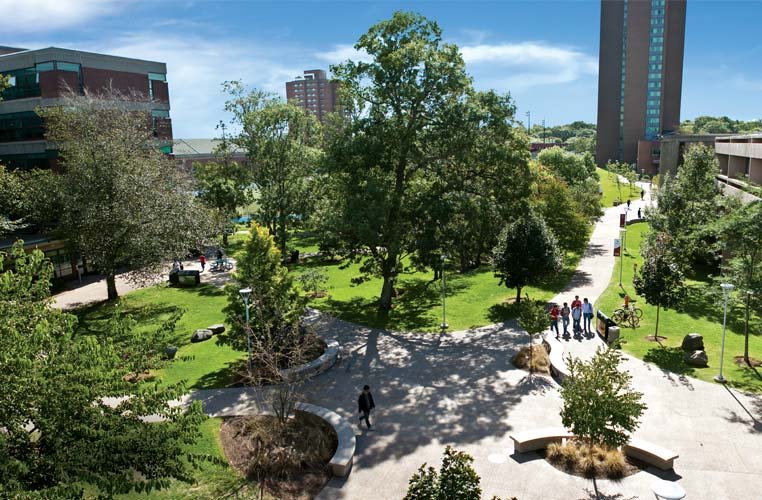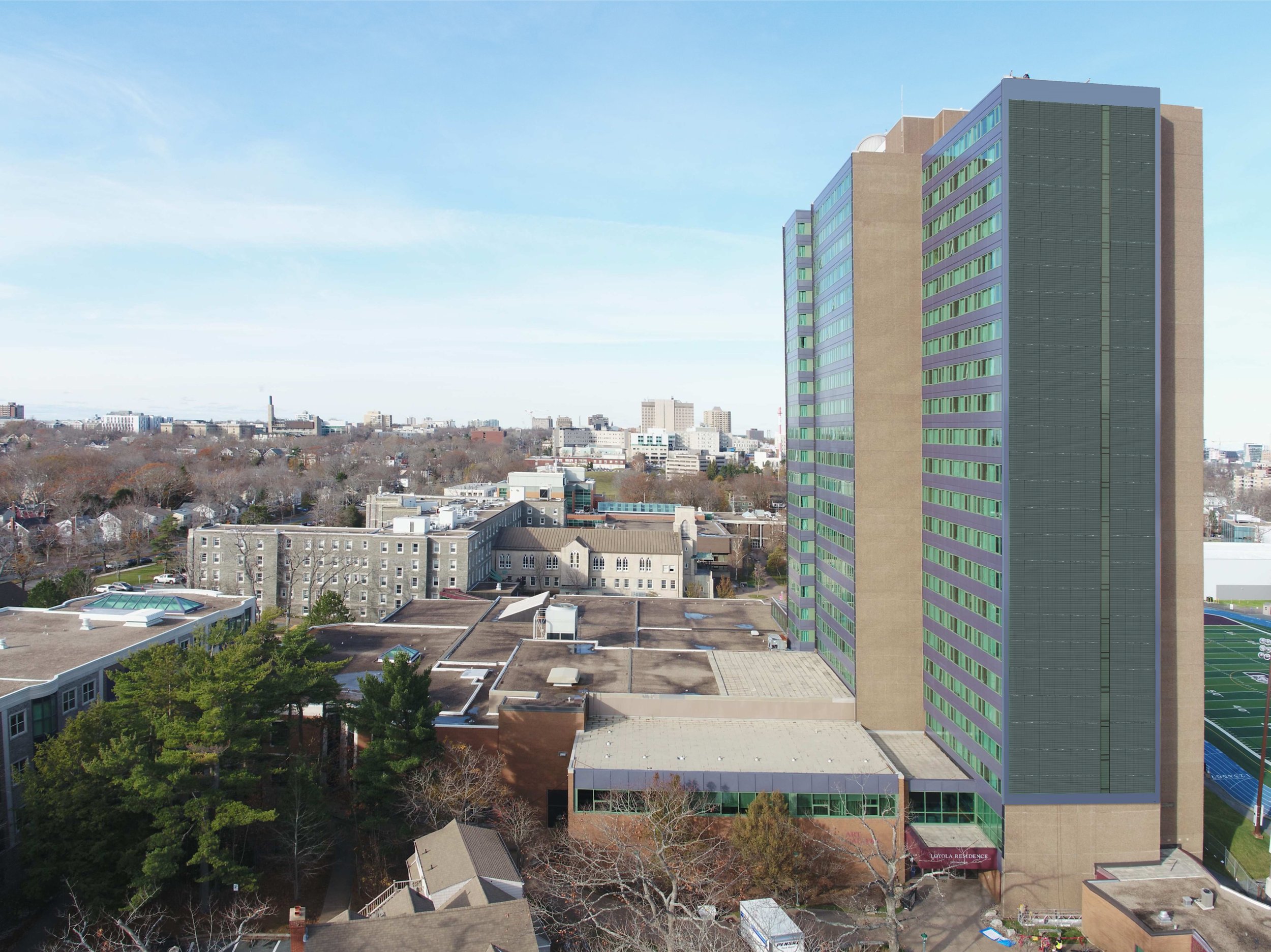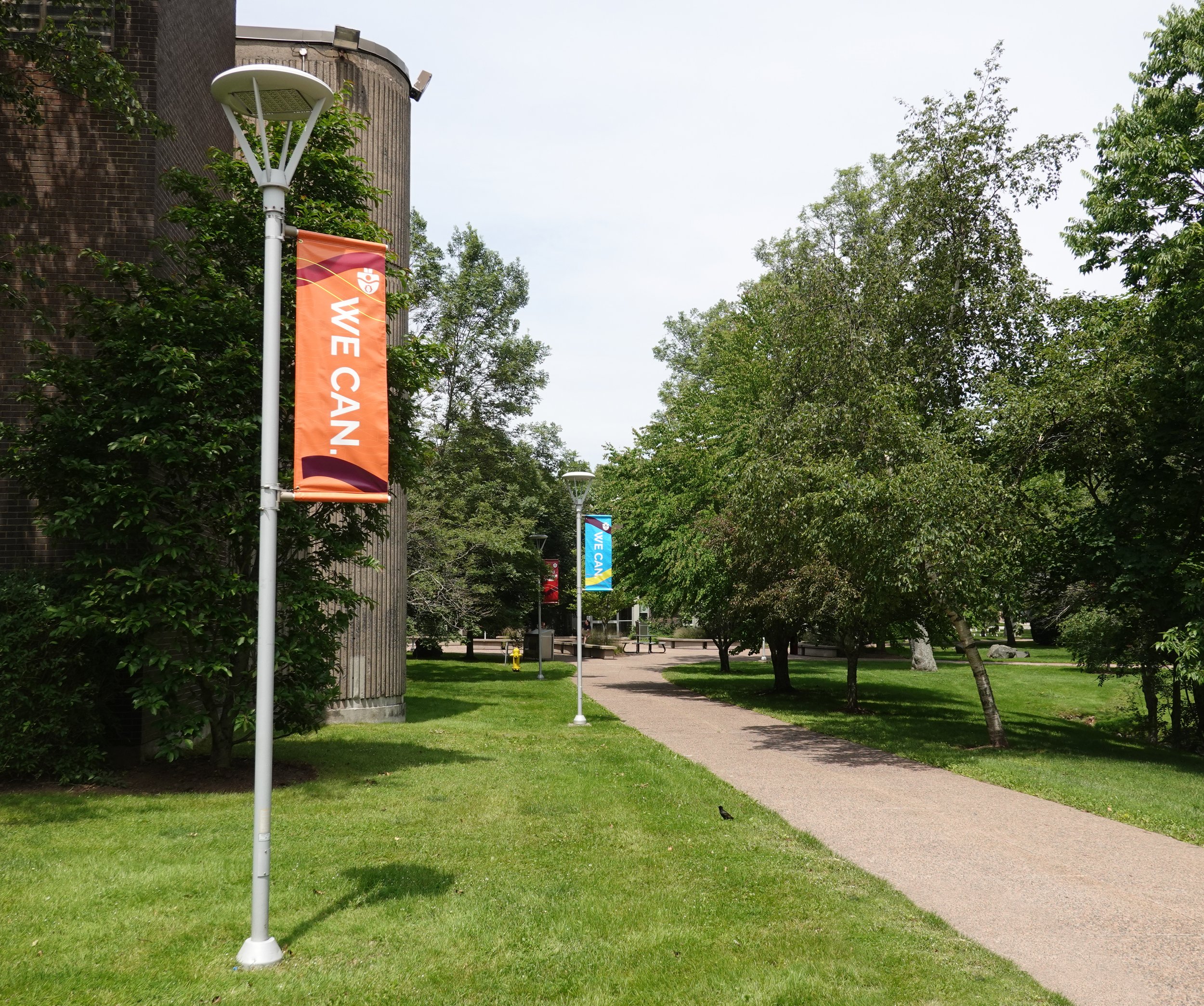The newest addition to campus—the Sobeys Inspiration Hub—opens in Fall ’23. Watch for a behind-the-scenes tour of this inspiring building in progress.
Saint Mary’s installs new bike repair station
You may have recently noticed a bright orange post outside the Language Centre – it’s a convenient and easy-to-use self-service bike repair station! As part of his work term as a Facilities Assistant with the university, engineering student (and bike enthusiast) Oluwatomiwa Dotun-Olutola spent months researching and building the perfect tool for SMU campus.
Designed as an on-the-spot tool that lets the average cyclist do simple repairs, the bike repair station features a place to suspend a bike, a pump with multiple valves, and a collection of tools for other adjustments. The station also provides educational videos and step-by-step guides to fix basic issues via a QR code.
“I think the station is a wonderful addition to campus,” says Dotun-Olutola. “It is great for sustainability and accessibility. I am eager to see people take advantage of it.”
This project aligns with Saint Mary’s green initiatives and sustainability commitment. Learn about our sustainability initiatives here.
Check out the new station outside the Language Centre!
Saint Mary’s research into sustainable agriculture and more efficient 3D modeling receives federal funding
The Science Building at Saint Mary’s University.
Research into sustainable agriculture and more data-efficient 3D modeling will benefit from newly announced federal funding through the Canada Foundation for Innovation’s (CFI) John R. Evans Leaders Fund (JELF).
Funding for biology researcher Dr. David Chiasson will allow him to explore sustainable agriculture practices in a project titled “Symbiotic nitrogen fixation in legume plants.”
Dr. David Chiasson
“A central goal of sustainable agricultural practice is to provide nutritious food and plant products while minimizing the impact on the environment,” says Dr. Chiasson. “Legume plants such as beans, alfalfa, and clover are a key component of sustainable agriculture since they do not require nitrogen fertilizer for growth. This unique group of plants forms a symbiotic relationship with soil bacteria called rhizobia. Rhizobia can convert nitrogen gas from the atmosphere into nitrogen fertilizer for the plant in a process termed nitrogen fixation. This association therefore reduces the need for applied nitrogen fertilizers in agriculture.”
The production of synthetic nitrogen fertilizers consumes vast quantities of fossil fuels, and their application leads to negative environmental outcomes such as greenhouse gas emissions and contaminated water resources. Coupled with the rising price of fertilizers, farmers are increasingly turning to legumes as a sustainable means of adding nitrogen to the soil.
“The long-term goal of this project is to increase the productivity of legume plants,” explains Dr. Chiasson. “This research will provide the knowledge base for strategies aimed to reduce the environmental impact of the agricultural sector while increasing the productivity of our crops. An improved understanding of the nitrogen-fixation symbiosis is both timely and essential as we move towards a future of more environmentally responsible farming practices in Canada.”
Dr. Jiju Poovvancheri, a researcher in the mathematics and computing science department, received funding for a project titled “Research Infrastructure for Large-scale 3D Geometry Acquisition and Modeling.”
“The CFI fund will be used to set up the lab and purchase research equipment including an AI server, Light Detection and Ranging (LiDAR) scanner and high-performance workstations capable of acquiring and processing large-scale three-dimensional data,” says Dr. Poovvancheri.
Dr. Jiju Poovvancheri
Current practices in city modeling include acquiring raw measurements of the physical world using LiDAR sensors and turning the sensor data into three dimensional meshes. Large-scale meshes created in this manner normally contain trillions of triangles, putting a huge burden on rendering, data transfer and storage of applications. Furthermore, most of the reconstructed meshes lack geometric details and therefore do not represent a good choice for 3D navigation, and AR/VR.
“High fidelity digital representations of cities are essential for modern-day applications such as urban planning, 3D navigation, and augmented/virtual reality (AR/VR),” explains Dr. Poovvancheri. “This project aims at bridging existing gaps in urban modeling pipeline by developing an AI (Artificial Intelligence) driven urban modeling software ecosystem consisting of algorithms, tools, and data for creating lightweight and highly detailed 3D urban models.”
The Honourable François-Philippe Champagne, Minister of Innovation, Science and Industry, announced more than $64 million to support 251 research infrastructure projects at 40 universities across Canada.
Competition to solve freshwater issues begins in Atlantic Canada
Field sampling is an important part of the work Environmental Science students do in classes and in research work with professors. Photo Credit: Dr. Linda Campbell
A competition to solve Atlantic Canadian water issues through technology, innovation and entrepreneurship begins this week. The competition is organized by AquaAction in partnership with Saint Mary’s University.
“We are excited to bring the AquaHacking Challenge back to Atlantic Canada,” says Dr. Anne-Pascale Richardson, AquaHacking Challenge Program Manager at AquaAction. “AquaAction’s mission is to restore freshwater health in North America. We do this by engaging with local communities to empower talented young innovators and support them as they work to improve freshwater in their region. The first Atlantic Canada AquaHacking Challenge was a great success, and we look forward to this year’s competition.”
Atlantic Canada is home to a spectacular system of dynamic freshwater and marine environments. Water is core to ecosystems and communities across the region. The Atlantic Canada AquaHacking Challenge brings students, developers, designers, scientists, programmers, engineers, technology enthusiasts and entrepreneurs together to form interdisciplinary teams to tackle different freshwater challenges facing these important ecosystems.
The issues they’ll be focusing on are:
Innovations for alteration projects in Lakes and Rivers
Water Issue Leader: Nova Scotia Environment and Climate Change - Water BranchAffordable Automated Water Quality Monitoring
Water Issue Leader: Eastern Charlotte Waterways Inc.Saltwater Intrusion
Water Issue Leader: Clean Foundation’s Clean Coasts teamAquatic Invasive species
Water Issue Leader: Coastal ActionGreen Infrastructure (Stormwater Prevention)
Water Issue Leader: ACAP Saint John
“AquaHacking is the type of interdisciplinary competition that allows students and young people to apply their knowledge to practical, real-world situations,” says Michael Sanderson, Director of the Saint Mary’s University Entrepreneurship Centre (SMUEC). “We are proud to partner with AquaAction to bring this great competition back to Atlantic Canada.”
Participants should have an interest in problem solving, collaborating with students from various faculties and applying innovative solutions to bring impactful change to communities in the Atlantic region. They are required to be between 18-35 years of age, a resident of Canada within the Atlantic region and enrolled in a post-secondary institution or be a recent graduate. The entire team doesn’t need to be residing in the Atlantic region, but the majority of the team should be within the Atlantic region.
“Our students are excited and ready to challenge the freshwater issues facing Atlantic Canada,” says Adam Khamis, the Project Coordinator of Skills, Development and Training with SMUEC. “This competition is a dynamic blend of entrepreneurship, social action and science that offers students a unique opportunity to work with people in areas they may not otherwise have discovered.”
After working on their pitches for nine months, all teams will have the opportunity to pitch their solution during the AquaHacking semi-final event. The top teams are selected from these pitches to go on to phase two of the program. These finalists receive $2,000 to support the continuation of their work as they refine their solution in preparation for their pitch at the AquaHacking finale. All five finalist teams are winners, receiving kick-start business training, leadership training, a spot in a local incubator, Lavery Lawyers credits and seed funding based on their final ranking.
For more information about the challenge, how to participate and the great partners that support the competition, visit https://aquaaction.org/challenge/atlantic-canada-2022-23/.
About AquaAction
AquaAction is a non-profit organization dedicated to restoring the health of freshwater by engaging young innovators in solutions creation and supporting the activation of their technologies. Its flagship program is the AquaHacking Challenge, a tech innovation competition which aims to engage university students in developing new solutions to water issues. Recently AquaAction developed the AquaHacking alumni and AquaEntrepreneur Québec. Across Canada, 36 water technology startups have emerged from the Challenge. AquaAction was established by the De Gaspé Beaubien Foundation in 2015, is powered by the RBC Foundation since 2018, accelerated by Ovivo since 2017 and supported by several partners including IBM Canada, Lavery Lawyers, and Mitacs.
SMU researcher says learning about and living the ideals of fair trade starts with a conversation
Dr. Gavin Fridell (centre), with Joey Pitoello and Vicki Matthews of Just Us! Coffee Roasters Co-op in Grand Pré, Nova Scotia. Just Us! serves as a community partner and case study for Fridell’s fair trade classes at Saint Mary’s University. CREDIT: Ian Selig.
Creating local to global connections in a meaningful way to foster equitable, ethical and sustainable trade relationships is what the fair trade movement is all about.
And according to Saint Mary’s University (SMU) researcher Dr. Gavin Fridell, the challenge is to achieve these objectives by combining certification and advocacy into a united movement.
Fridell says that while there’s no one road to fair trade, people who are interested can, “use that fair trade cup of coffee or banana as a moment of reflection on what you think the world needs.” PHOTO CREDIT: Ian Selig.
A Canada Research Chair in International Development Studies at SMU, Fridell studies issues around trade from both social and social justice lenses, including perspectives of politics and history.
As a long-time advocate for price regulations, and after years of collaboration with groups including the Canadian Fair Trade Network, Fridell also delves into more abstract mechanisms of fair-trade advocacy, rules and politics in the global trading world.
“There’s a need for real government support and government policies for small farmers to thrive,” Fridell says. “If you remove government support, you open up the market to the largest players, who very often crush the small ones.”
Locally, the Just Us! Coffee Roaster Co-Op in Grand Pré models many of the objectives that Fridell advocates for. Run as a democratic co-operative with an awareness of social, environmental and economic impact, partnered with small-producer farm co-ops in the global south, Just Us! serves as a community leader and case study for his students, including a class field trip to the roaster.
In his classes and on the broader university campus, Fridell says he’s observed interest in fair trade from others, but that the challenge is translating these interests into impact, and lessening barriers to doing so.
“I don’t think there’s one simple road, but you can use that fair trade cup of coffee or banana as a moment of reflection on what you think the world needs,” says Fridell. He says this awareness can be the beginning for thinking politically about what it means to live in a world with so much unfair and unsustainable trade.
For those interested in advancing the goals of Fair Trade, Fridell recommends The Fair Trade Handbook: Building a Better World, Together. Published in October 2021, the handbook features contributions from fair-trade organizations and researchers, including Fridell as author and co-editor.
“The book is designed to motivate ideas and energize people to get involved in fair trade, but the discussion also acknowledges the limits of fair trade,” says Fridell. “The book can be read as a continual dialogue which is, I think, what fair trade should be, ultimately.”
For more information on Dr. Gavin Fridell’s research, visit smu.ca/researchers/arts/gavinfridell/.
Minister of Environment and Climate Change, Tim Halman, tours Belcher Street Marsh Site



















Saint Mary’s University professor Dr. Danika van Proosdij and her TransCoastal Adaptations team members had the opportunity to present their work to the Honorable Tim Halman, Nova Scotia Minister of Environment and Climate Change. The presentation included an interactive tour to showcase the design, implementation and monitoring of the Belcher Street Marsh Dyke Realignment and Tidal Wetland Restoration Project.
The project includes 75 hectares of tidal wetlands along Nova Scotia’s Bay of Fundy that van Proosdij’s team is working to restore habitat and protect against flooding and coastal erosion. Using nature-based strategies and restructuring old dyke infrastructure, the team creates new tidal wetlands to absorb rising sea levels, protect nearby communities and create new ecosystems for marine life.
The newly realigned dyke at the Belcher Street Marsh protects the active agricultural land behind it. The restored tidal wetland will increase the natural absorption of wave energy during storms, thereby protecting the dyke. The expanded floodplain provides more room for floodwaters. The new marsh is now a productive natural habitat supporting species diversity. The dykes overlooking the new marsh provide a recreational opportunity for enjoying nature and connecting to the restored natural condition of the site. The site is a living laboratory and training site to develop dykeland realignment and marshland restoration skills.
Want to learn more? Join TransCoastal Adaptations for a workshop on Climate-Resilient Coastal Nature-Based Infrastructure, June 29–30.
TransCoastal Adaptations is a Centre for Nature-Based Solutions at Saint Mary’s University that engages in research and partnerships that promote and undertake projects related to climate change adaptation.
Saint Mary’s University exceeds goal and timeline for greenhouse gas reduction
Saint Mary’s University has achieved its 2025 target for greenhouse gas reduction three years early.
“Sustainability is an institutional pillar for Saint Mary’s University,” says President Dr. Robert Summerby-Murray. “Using a sustainability lens in our operations allows us to find efficiencies and opportunities to address financial uncertainties while reducing our environmental footprint. I am proud to share that Saint Mary’s University has reduced its greenhouse gas emissions in excess of 40 percent, putting us on a strong footing to meet or exceed the provincial goal of a 53 percent reduction by 2030.”
Saint Mary’s exceeded its 40 percent reduction by 2025 goal through a series of projects that finished this year.
“This achievement comes from the forward-thinking and consciousness of many faculty and staff members over the years, the efforts of facilities management and the support of key university executives such as President Summerby-Murray,” says Dennis Gillis, Senior Director of Facilities Management at Saint Mary’s. “We are exceeding our emissions reduction goal, and with innovative projects such as North America’s tallest solar-integrated building Saint Mary’s is taking a leadership role in the post-secondary sector towards a more sustainable future.”
Fundamental changes that support emissions reduction include:
replacing the steam heating plant with a high-efficiency hot water plant;
switching from oil to natural gas for heating;
using compact fluorescent lights;
replacing less efficient lights with LED lights; and
increases in Nova Scotia Power’s energy blend from renewable sources.
From 2005 to 2019, the university's overall emissions reduction was 36.8 percent. In 2021, a conversion from steam to hot water for the university’s central heating plant increased the total emissions reduction to over 40 percent. Further emissions reductions are on the way from the upcoming solar-integrated project at the university’s Loyola residence, the incorporation of solar panels at the Sobeys Inspiration Hub currently under construction, and other forthcoming solar and green energy projects.
All targets and goals use 2005 as the baseline year per the provincial government’s Environmental Goals and Climate Change Reduction Act.
Ropeless Fishing Reduces Harm to Whales
Dr. Jason Rhinelander and Ross Arsenault
By Jessica Long
As an Engineering professor and an expert in Artificial Intelligence, Dr. Jason Rhinelander’s research focuses on applying machine learning and optimization to embedded, real-time systems. Dr. Rhinelander was Ashored Inc.‘s academic supervisor for a project entitled, “Environmental testing of existing and proposed ropeless fishing system line management methods,” which was funded in part by Mitacs through the Accelerate Entrepreneurship program. Ashored Inc. has been developing a “rope-on-command” fishing system which reduces lost gear, automates the collection and dissemination of gear data, and allows fishing to continue sustainably in zones closed for animal protection.
Under Dr. Rhinelander’s supervision, Ross Arsenault, Co-Founder and Chief Operations Officer of Ashored Innovations, and Saint Mary’s Alumni (BComm’18 MTEI’20), explored respooling and resetting buoy lines from trap fishing applications into caged ropeless fishing systems. The results of this research allowed Ashored to design a modular rope and release cage that can be used seamlessly in real world commercial trap fishing. This lidded cage design streamlines the time required to reload the system with the buoy line for deployment to merely a few seconds.
“When we started Ashored, there were a number of unknowns and variables that we needed to solve before we could develop a rope containment unit for our rope-on-command fishing systems,” says Arsenault. “By engaging with the Office of Innovation and Community Engagement and Mitacs, we were able to put together a project that allowed us to learn essential information and test our hypotheses in a scientifically vetted process and in a resource-rich environment. We received both the freedom and framework to succeed in our project and had expert mentorship to fall back on if issues or surprises arose in our research.”
Photo (L-R): Dr. Jason Rhinelander and Ross Arsenault
The Office of Innovation and Community Engagement facilitates research relationships between Saint Mary’s University and companies, government departments and community organizations.
Read about more innovative partnerships between Saint Mary’s University faculty and industry partners in their 2022 report.
Will electric bills ever go down? It’s likely, if this SMU researcher has it his way using renewable energy
Dr. Adel Merabet
Lowering electricity costs and decreasing CO2 emissions is something Dr. Adel Merabet aims to achieve through his work in renewable energy integration at Saint Mary’s University.
Merabet leads the Laboratory of Control Systems and Mechatronics, a research laboratory centred on engineering and technology.
“My lab works on developing control and management systems for renewable energy integration and efficient usage of battery storage to increase their operational capacity and productivity,” says Merabet.
For an industry project in Yarmouth, Merabet has developed machinery software and hardware to increase efficiency; he has also worked on automated machinery that regulates temperature systems in large-scale manufacturing equipment for Halifax-based Reused Plastic.
“These projects provide technology transfer to local industries and provides hands-on experience to my students, something that will be helpful for their future careers,” says Merabet.
In February 2021, the province of Nova Scotia set a goal of using 80% clean energy by 2030 as part of its Environmental Goals and Climate Change Reduction Act. Merabet’s research focuses on finding alternatives to traditional energy sources, including renewable sources and battery storage tech.
As Nova Scotia’s population grows, so too does its electricity demand. This is why he says building a big, pricey power plant is not the solution. “We need to look at small microgrids and develop technology to exchange between them, to generate power in city centres like Halifax.”
Microgrids are self-sufficient, harnessing solar and wind energy to produce electricity to create and localize energy that can be used by nearby buildings. Many use batteries for energy storage, allowing electricity to be used during power outages.
And while renewable sources like solar and wind depend on variable amounts of sunlight or wind, the way they are stored, and how that battery storage works, is vital. Part of Merabet’s research includes finding more efficient battery solutions for the transfer of renewable energy.
Merabet says that by using more efficient methods of battery storage in combination with renewable energy, diesel fuel consumption can be reduced, electricity costs will be lower, and CO2 emissions will decrease, benefiting our pocketbooks and the environment.
“With better battery storage combined with microgrids, we can use that source of energy over a long period of time,” says Merabet. “This will especially benefit remote and rural communities, so they don’t have to rely on diesel generators.”
For more information on the great research taking place at Saint Mary’s University, visit news.smu.ca/research.
Leading the Way to Greener Energy: Retrofit Project Creates North America’s Tallest Solar-Integrated Building
A rendering of the Loyola Residence retrofitted with building-integrated photovoltaics.
The tallest solar integrated building in North America will be at Saint Mary’s University on the completion of a new project at the Loyola residence building.
“Universities are at the forefront of producing green energy and related research. We are essential partners in the fight against climate change,” says Saint Mary's University President Dr. Robert Summerby-Murray. “With this new initiative, we are building on our history of projects to reduce greenhouse gas emissions and produce green energy. Saint Mary's will be a leader in North America in producing solar energy through building-integrated photovoltaics.”
Saint Mary’s is working with Mitrex, a Toronto-based manufacturer of building-integrated photovoltaics (BIPV). BIPV are solar power generating products or systems that are seamlessly integrated into a building’s envelope and part of building components such as façades, roofs or windows. This project will transform an exterior wall of the Loyola residence with an integrated solar façade solution, the tallest and largest BIPV micro-grid application in North America. The implementation of the project will be done by DSRA Architects, Dillon Consulting, and BMR Structural Engineering, with construction overseen by the EllisDon Corporation and Grey Cardinal Management Inc..
“As this project began, we knew that a portion of the external envelope on the university’s Loyola residence needed to be replaced,” says Dennis Gillis, Senior Director of Facilities Management at Saint Mary’s. “We decided to go bolder than a traditional envelope refurbishment. We saw the opportunity to create a green energy retrofit project in Atlantic Canada, an exemplar to other organizations of what is possible when we think outside the box, as we all work to reduce our carbon footprint.”
Instead of simply replacing and repairing the pre-cast panel façade, this project will install aluminum panels with integrated solar photovoltaics from top to bottom on the south side of the Loyola residence facing Gorsebrook Avenue. This installation will create clean energy for the campus, approximately 100,000 kWh annually, further reducing the university’s greenhouse gas emissions and moving Saint Mary’s further along the path to net-zero.
This project represents an $8.5 million dollar investment by Saint Mary’s University in green energy.
















